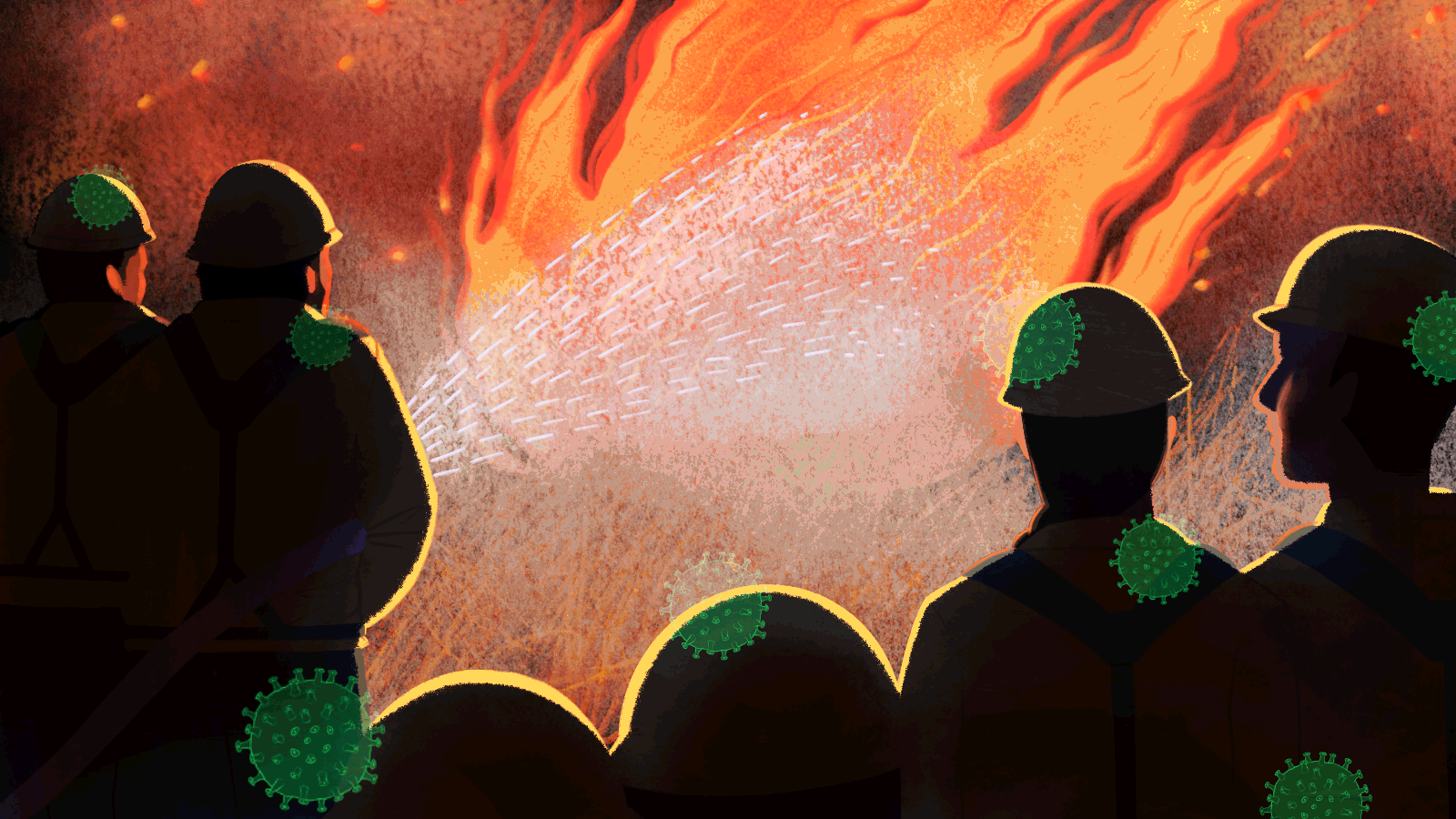As you read this, thousands of wildland firefighters, the men and women who protect property and ecosystems from burning to a crisp, are getting ready for a busy season of brutal work. All of the steps government and health officials have advised Americans to take to avoid the novel coronavirus — stay home as much as possible, social distance from others, wear a mask — are completely at odds with the norms these firefighters live by. In their world, putting on a face covering isn’t worth the hassle, and toughing it out is a way of life.
Wildland firefighting crews are different from the firefighters who work at your local fire department — the ones who might show up at your house if you call 911. Wildland firefighters generally don’t interact with the public at all. Most of them work during spring and summer months in the “wildland-urban interface” — the zone where human development and vegetation intermingle.
Each crew usually consists of between 18 and 22 firefighters — including one superintendent, who oversees the whole operation, and two or three squad bosses, who manage the employees day-to-day. Some of the firefighters camp or rent rooms near a fire station that serves as their unit’s home base; others live on-site in barracks. When they’re given a fire assignment, they hit the road, sometimes traveling hundreds of miles to reach a blaze.
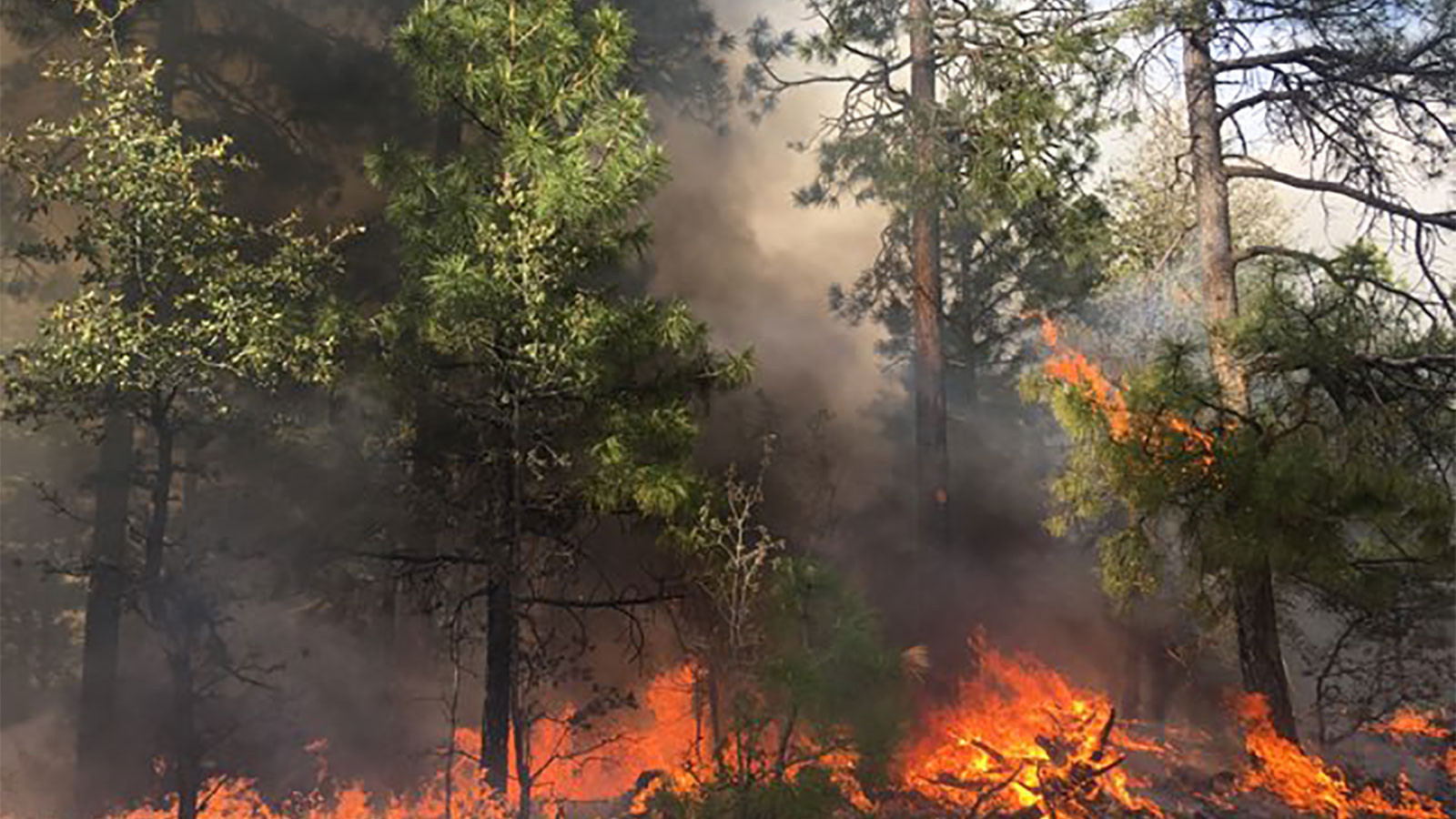
A fire burns in Arizona’s Tonto National Forest during the 2019 season. Alexandru Oarcea
Administration of wildland firefighting in a nation as large as the United States functions something like a patchwork quilt. At the national level, the Bureau of Land Management, the Bureau of Indian Affairs, the National Park Service, the U.S. Fish and Wildlife Service, and the U.S. Forest Service oversee fires in their respective jurisdictions. The Forest Service is the largest of these — it manages 193 million acres of national forest and grassland, as well as about two-thirds of all of the country’s wildfire resources, including personnel and equipment like fire engines and helicopters. The National Multi-Agency Coordinating Group — an organization made up of representatives from each of the federal agencies that work on wildfires, plus the Federal Emergency Management Administration, or FEMA, and state forestry agencies — facilitates communication and planning between the various quilt patches.
Then there are state agencies, like California’s renowned Cal Fire, which oversees wildland firefighting units ready to respond to wildfires within their borders. There are also private companies — which operate autonomously — recruit, train, and deploy their own crews. Those private contractors are usually tapped by federal agencies midway through or toward the end of fire season, when multiple fires are raging and state and federal firefighters need backup.
Each of those federal agencies, state departments, and private companies have fought fires for years using their own protocols and methods. Now, all of those moving parts have to work together on the fly to come up with a plan to protect wildland firefighters from contracting COVID-19, which has the potential to run rampant through these essential workers who are responsible for keeping hundreds of thousands of Americans safe each year. The first case of the season has already been reported: In mid-May, a wildfire engine crew leader in Washington State who was supposed to start work on June 1 tested positive for the coronavirus.
Keeping wildland firefighting crews safe this year will require a significant shift in the way the country has fought wildfires for decades. But that shift, according to wildland firefighters Grist spoke to, hasn’t materialized yet. States and federal agencies, their resource pools sucked dry by the coronavirus pandemic, are scrambling to come up with a plan to protect these men and women on short notice.
“The 2020 fire year is different than any we have previously experienced,” Victoria Christiansen, chief of the Forest Service, wrote in an annual letter to regional foresters, station directors, and agency bigwigs on April 3. “We are changing how we approach fire management options during the COVID-19 pandemic across the board to adjust to this unprecedented challenge.” The letter, however, offered few specifics on what that new approach actually entails.
So some members of Congress pressed the issue.
On April 30, 11 Democratic U.S. senators — led by Ron Wyden of Oregon and including former presidential candidates Kamala Harris and Michael Bennet — sent a letter to Christiansen asking her to answer nine questions about how the agency plans to suppress wildfires this year amid the pandemic. “Preventing the spread of COVID-19 may require a radical new approach to transporting, provisioning, and sheltering fire crews while on assignment,” they wrote. “What measures and training protocols are the agency implementing to mitigate COVID-19 virus exposure and response in the event of transmission during wildfire season?”
As of Tuesday, Wyden’s office said that the Forest Service had not responded to the letter yet.
“They’re basically saying, ‘Good luck, guys!’,” said Alexandru Oarcea, an elite wildland firefighter known as a “hotshot,” who receives extra training to tackle the toughest part of a fire. “There’s no direction from above.”
Most of the time, wildland firefighters’ work amounts to preparing for the next fire. At the beginning of the season, they engage in intensive training exercises to physically and mentally prepare for the season ahead. One of those exercises, called the work capacity test, requires firefighters to walk at a fast clip while carrying a 45-pound backpack for three miles in less than 45 minutes. Firefighters also have to complete coursework in order to finish their training. After training is over and between fire assignments, firefighters clean their gear and get it ready, patrol for fires, and do project work like trail maintenance and managed burns.
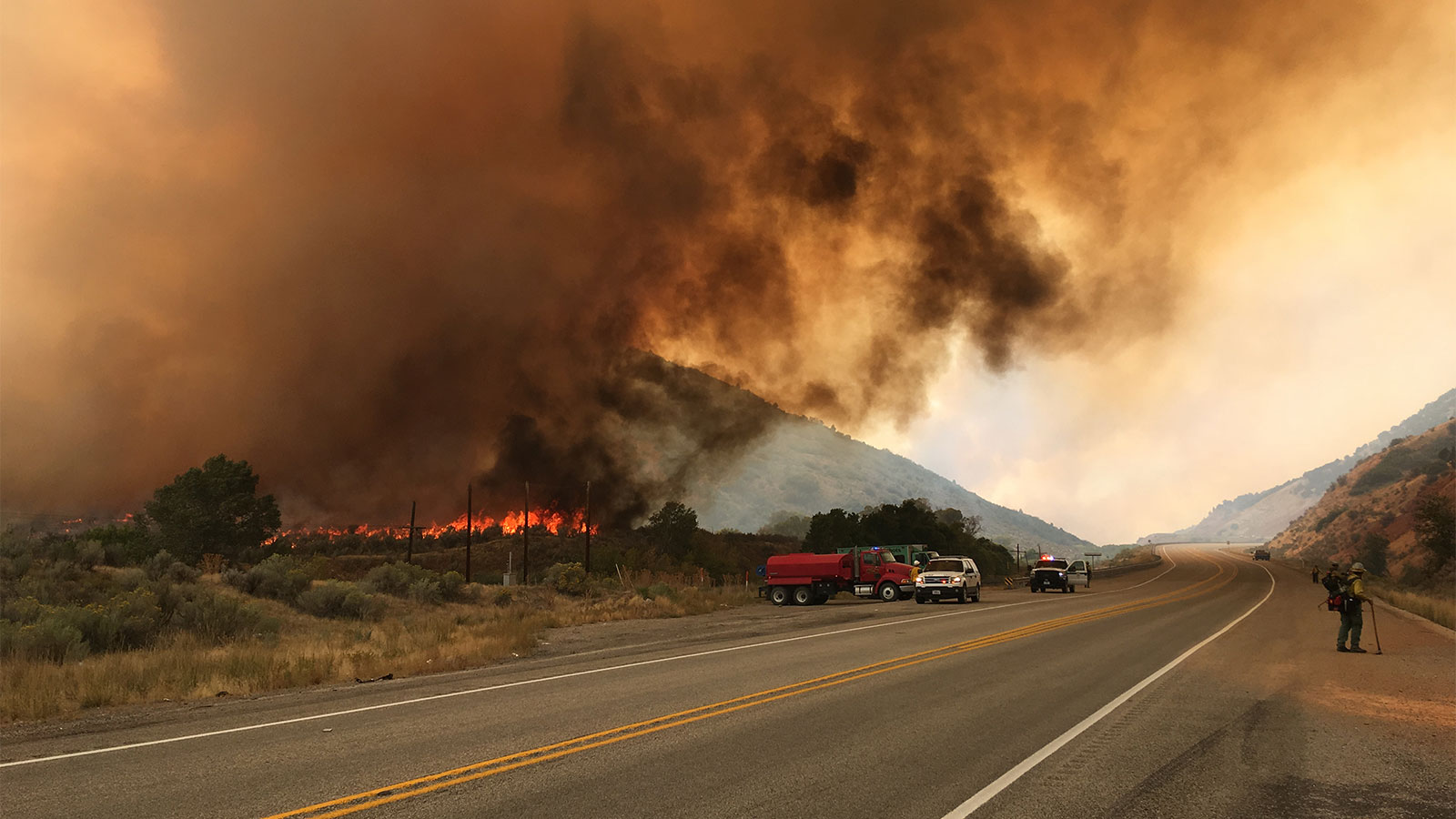
Crews work to extinguish a 2018 road-side blaze in Utah. Alexandru Oarcea
But even when things are slow, the seasonal, makeshift nature of wildland firefighting will present unique challenges to keeping COVID-19 at bay. Firefighters who camp near their units have to go to the grocery store every day or every other day for food — refrigeration isn’t an option when you’re living in a tent in hot weather. Frequently visiting closed spaces populated with others means potentially exposing themselves to the virus multiple times per week. Tent living also makes maintaining personal hygiene tricky, a problem that’s compounded by the fact that there’s still a national shortage of products like disinfecting wipes.
Whether each unit makes changes to enforce social distancing depends in large part on that crew’s superintendent. “Each crew and department is its own little microorganism, and each one has its own culture,” said Anastasia Selby, a former hotshot who worked for the Forest Service and the Park Service in the West and Alaska for seven years. Lack of a uniform approach to the virus across the nation could result in a situation where some units take adequate precautions while others don’t.
“No one’s been in this position before,” Selby said. “This is a high-level decision that needs to be made with input from people who are experts on pandemics. It’s not meant to be made by supervisors.”
The Forest Service says all its wildland firefighting units are following the Centers for Disease Control and Prevention, or CDC, guidelines for reducing the spread of COVID-19. In some cases it’s done away with the work capacity test — which requires firefighters to walk together in a line — in order to cut down on time employees spend in close proximity to one another.
In addition, the National Multi-Agency Coordinating Group released Wildland Fire Response Plans (WFRPs) for its 10 geographic subregions of the U.S. as of the beginning of May. The plans, which are each between 80 and 110 pages long, identify potential risks to firefighters this season and outline recommendations for avoiding infection from the novel coronavirus. The recommendations, the plans say, “provide a higher-level framework” and are “not specific operational procedures” — which seems to imply that much of the nitty-gritty decision-making will still get hashed out on a crew-by-crew basis this summer.
“The guidelines laid out in the Wildland Fire Response Plans are designed to be localized,” said a spokesperson for the Forest Service in an email to Grist. “State and local unit fire managers are encouraged to use the WFRPs to develop their own strategic and tactical plans for fire suppression operations during the COVID-19 pandemic.”
Alexandru Oarcea is currently living in an Arizona apartment for the next few months, so he can fight fires for the Forest Service. His superintendent has been taking precautions since before the Southwest regional plan was published. The Forest Service allowed Oarcea and other veteran firefighters to skip the work capacity test this season because of the pandemic, although new recruits still had to do it. He said his superintendent is following CDC guidelines for limiting exposure to coronavirus. Instead of sending Oarcea’s entire team of 20 firefighters into the station to collect its gear at the same time, the superintendent split the team up into two crews. Oarcea was given a mask for grocery runs and advised to be careful out in public. He has to fill out a sheet every day stating where he traveled that day and if he is experiencing any symptoms.
And unnecessary physical contact is also limited. “We all show up to work and we can’t hug people we haven’t seen in months [and] that we live with for six months out of the year,” Oarcea said.
He’s also been doing a lot of his training coursework online from his house, where he lives with three other wildland firefighters. They work on three separate crews for the Forest Service’s local district, “so if we get sick basically all of the resources on the district will have first-hand contact [with the virus],” he said.
Even setting living arrangements aside, there are limits to how much wildland firefighters can keep clear of one another, said Brendan O’Reilly, superintendent of the Forest Service’s Prineville Interagency Hotshot Crew in Oregon. The National Multi-Agency Coordinating Group’s regional plans advise firefighters to both practice social distancing and finish fire assignments quickly so as to minimize contact. But some tasks — transporting firefighters to fires and digging breaks in vegetation to contain flames — require close quarters. “There’s not a lot of flexibility,” O’Reilly said. “What we’ve historically done does not work with the specific CDC guidance on social distancing.”
Even Oarcea thinks it’s just a matter of time before crews scrap the social distancing measures adopted by the Forest Service. “When shit hits the fan, which it will, all of these protocols will go out the window,” he said. “It’ll be a big mess.”
And it will likely get even messier when the first major wildfires of the season occur — and crews ship out to so-called “fire camps.”
When a particularly large fire breaks out, whichever agency has jurisdiction over the area where the fire occurs initiates the set up of a fire camp, which is then coordinated by a number of different agencies. These Incident Command Posts, as they’re formally known, are small, temporary cities that serve as bases for firefighters working to control a blaze that can sometimes grow to hundreds of square miles in size. Anywhere from a couple hundred to a couple thousand firefighters can congregate in those camps, depending on the size of the fire.
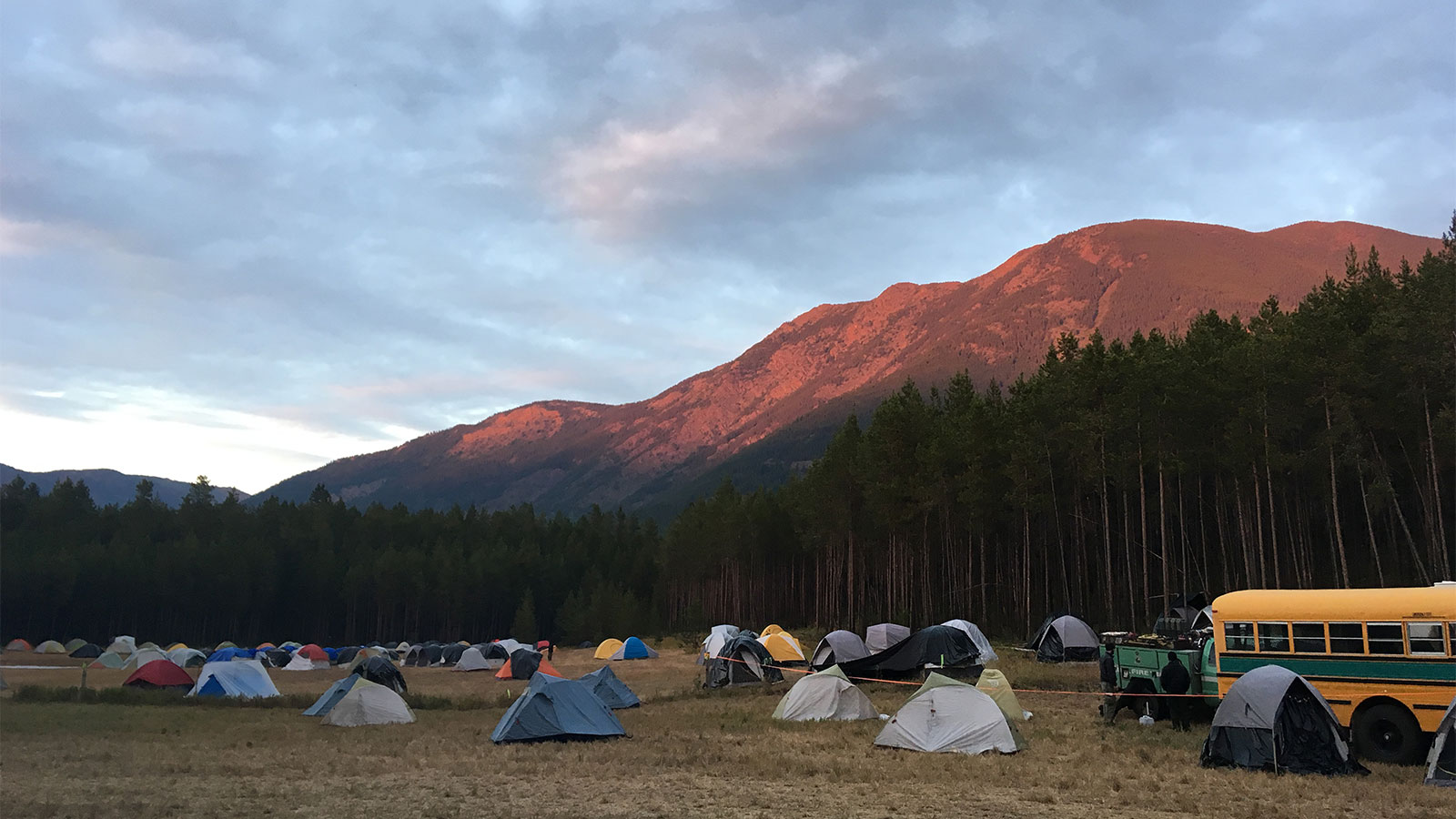
Dozens of tents populate a fire camp in Montana during the 2018 fire season. Alexandru Oarcea
After long days of battling flames and breathing in smoke, firefighters return to camp, where fumes still linger, porta-potty doors open and slam shut all night long, and camp managers start cranking generators at 4:00 in the morning.
Camps are not a place where hygiene is a top priority. When Selby was a hotshot working in Alaska, there were periods when she didn’t shower for two or three weeks at a time. “You get back from a fire at like 10 o’clock at night,” Selby said, “the last thing you want to do is take a shower.”
Even in COVID-free times, these temporary towns are ripe for the proliferation of illness — or camp crud as it’s called. About midway through the season, dehydration, lack of sleep, close quarters, and near-constant exposure to wildfire smoke prompt the spread of bugs that cause everything from respiratory distress to gastrointestinal issues. Mealtimes, especially, would provide ample opportunity for pathogens like coronavirus to spread. Firefighters get their meals through a “chow line” — basically a buffet big enough to serve dozens of people — and eat them at long picnic-style tables, crammed in next to each other.
Holly Kraake, program manager for the Forest Service’s Pacific Northwest region, told Grist that firefighters in Washington and Oregon will be asked to take common-sense precautions wherever possible to minimize exposure to the virus at fire camps. Instead of eating in communal dining tents, they’ll get boxed meals, she said. And the Service will limit the sharing of equipment, like helmets and radios. But no number of precautions can offset the risks inherent in the very purpose of those camps, which is to house vast numbers of firefighters close to a major blaze. “All the surfaces at a fire camp are high-touch surfaces,” Selby said. “Everything.”
O’Reilly with the Oregon hotshot crew doesn’t think camps will be safe for his firefighters. “I don’t plan to take the crew into a fire camp at all, if we can help it,” he said. “We’re gonna spend the least amount of time there that is at all possible.” It’s unusual for an entire hotshot crew to avoid camp altogether, but it is typical for some hotshots to “spike out” at night, make camp in the woods or elsewhere nearby the larger camp. (Normal wildland firefighters, who don’t enjoy the same cachet or autonomy as hotshots, are usually ordered by supervisors to stick to camp.)
The risk of communicable diseases isn’t just to other firefighters, but to the communities that surround fire camps. Each of the National Multi-Agency Coordinating Group’s regional plans notes the public health risk of bringing people from all over the country to fight fires in places where COVID-19 rates have been low. In some instances, the plans recommend “closed camps with security” — forbidding firefighters from leaving to visit nearby towns.
A Forest Service spokesperson told Grist that gathering firefighters in large groups in camps isn’t going to be “practical for providing adequate social distancing” this season. He explained that financial, timekeeping, and information systems that would normally exist within a fire camp will be virtualized this year. Large camps “are being replaced with smaller, more separated camps and crew briefings that allow social distancing for fire personnel,” the spokesperson also said.
He didn’t elaborate on how big the smaller camps and briefings would be.
The very nature of wildland firefighting may put firefighters at elevated risk of developing serious symptoms if they are unlucky enough to be infected with the novel coronavirus. Scientists have conducted studies on the effect of wildfire smoke on the general public, but there’s been little research on its effect on wildland firefighters. In 2018, researchers at Northeastern University received a $1.5 million grant from FEMA to expand the limited body of research on those effects. That team recently said that personal protective equipment might not be enough to protect wildland firefighters from COVID-19 because smoke inhalation increases the risk of disease complications.
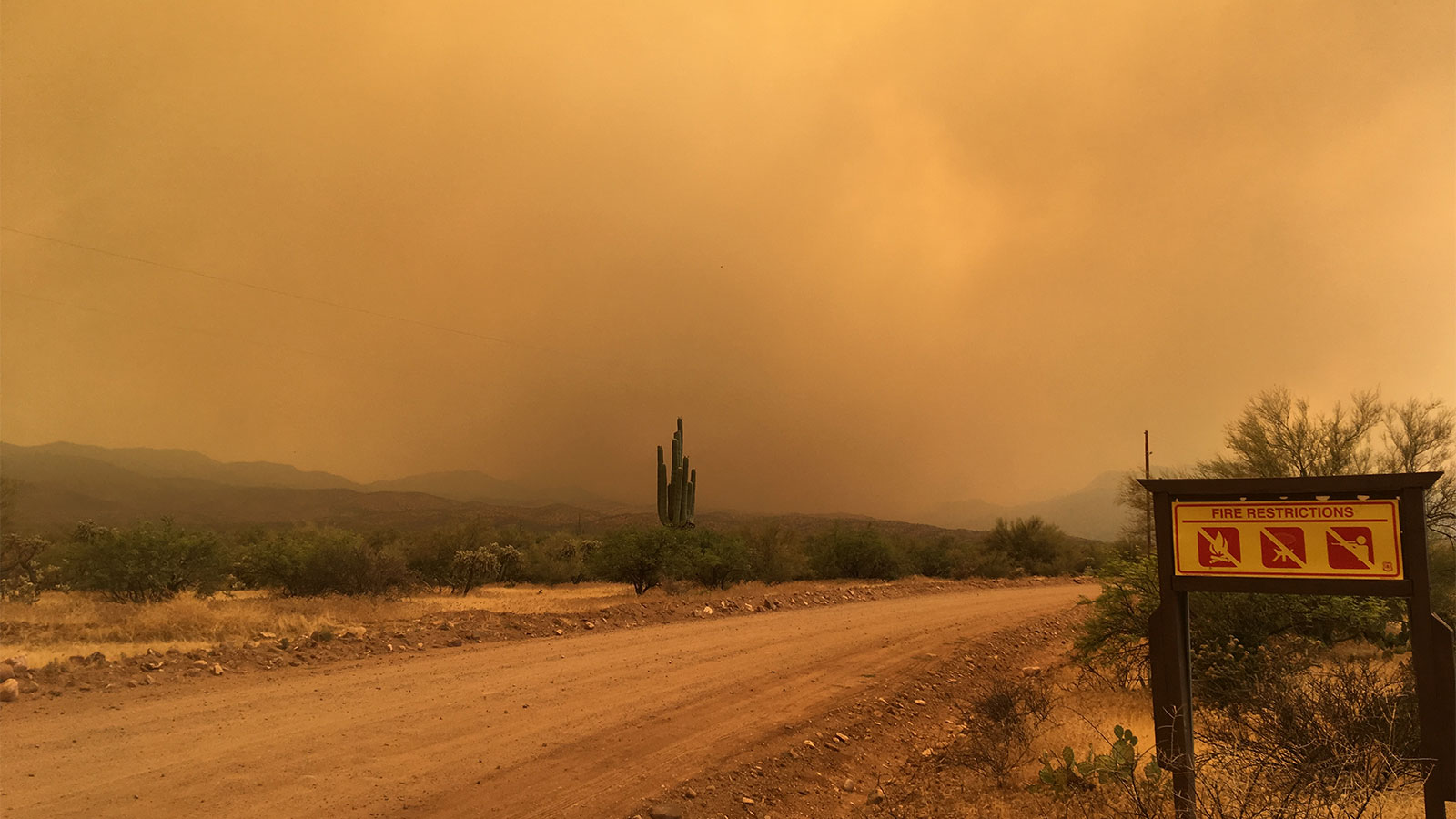
Smoke clouds the sky during a 2019 wildfire in Arizona’s Tonto National Forest. Alexandru Oarcea
A Harvard study published in March showed that even slightly elevated levels of fine particulate matter, a component of wildfire smoke, makes COVID-19 more deadly. In an opinion piece for The Conversation, Luke Montrose, an assistant professor of community and environmental health at Boise State University, said that the Harvard study, paired with recent research on the effect of wildfire smoke on health, could mean a perilous fire season for wildland firefighters. An internal Forest Service analysis obtained by the Associated Press estimated a worst-case scenario of a 6 percent “cumulative mortality rate” at large fire camps this year due to coronavirus — a shockingly high rate for a population that’s young and relatively healthy. The Forest Service now says that estimate is outdated, and revised it down to 2 percent.
Respiratory masks like N95s would help filter some of the particles inhaled by wildland firefighters and protect them from coronavirus transmission, but there’s a national shortage of those masks. The Forest Service, Bloomberg News reports, “has been directed to reduce and reuse PPE (personal protective equipment).”
The Forest Service says its firefighters are well equipped to prevent the spread of COVID-19. “Both wildland firefighting personal protective equipment and PPE related to reducing exposure to COVID-19 are available to wildland firefighters,” a spokesperson said in an email to Grist. The spokesperson also said that the agency has a plan to acquire adequate PPE for its firefighters nationally, but in the meantime that crews can buy PPE locally with agency funds.
“Fire personnel will be encouraged to wear a face covering over the nose and mouth,” Carpenter, lead public affairs specialist at the Forest Service, wrote in an email to Grist. But many firefighters wouldn’t wear protective gear even if it were available. Masks make it harder for firefighters to decipher each other’s facial expressions and hear each other above the roar of flames. They also make sucking in air during strenuous activity more difficult.
But O’Reilly noted the kind of masks that actually limit the amount of smoke someone breathes in aren’t feasible for the kind of work his crew does. “You run into the issue of weight and bulk and heat,” he said. Cloth coverings are easier to wear, he admitted, “except that they tend to fog up safety glasses and do nothing for smoke inhalation.”
O’Reilly didn’t say whether he’ll require his crew to wear face coverings this season.
Because most wildland firefighters are classified as seasonal and temporary workers, they don’t automatically qualify for government health insurance. The Forest Service offers part-time crew members subsidized insurance during the months that they work, but firefighters still have to pay for a portion of it out of pocket. Many opt to save what meager earnings they get from a season of firefighting — wildland firefighters can be paid less than the minimum wage in some cities — instead of spending it on health insurance. Oarcea, for instance, signed up for health insurance last year, but he’s not sure if he’s going to do it again this year. “I’m not afraid of the virus,” he said, despite his heightened risk from smoke exposure.
A potentially even bigger problem is that wildland firefighters get limited paid sick leave. People like O’Reilly, with 20 years of experience at the Forest Service, have stockpiles of leave they can pull from, but a temporary employee who is new to the job may only have one day available. The Families First Coronavirus Relief Act passed by Congress in March stipulates that the U.S. Department of Agriculture (which houses the Forest Service) has to provide all of its employees — even the temporary and seasonal ones — with up to 80 hours of paid sick leave, if the employee is unable to work and the state he or she is in has a coronavirus quarantine order in place. The employee only gets the extra paid sick leave if they were told to self-quarantine by a doctor or are actively looking for a COVID-19 diagnosis (making an appointment to get a test or waiting for the results of one). Employees who self-isolate without a doctor’s sign-off don’t qualify for sick leave.
O’Reilly is worried that his hotshots might not actually tell him when they’re feeling sick. “The real friction point is that there’s a financial disincentive for people to be honest about that,” he said. “Because if they don’t come into work and they don’t go on a fire assignment then they don’t make money.”
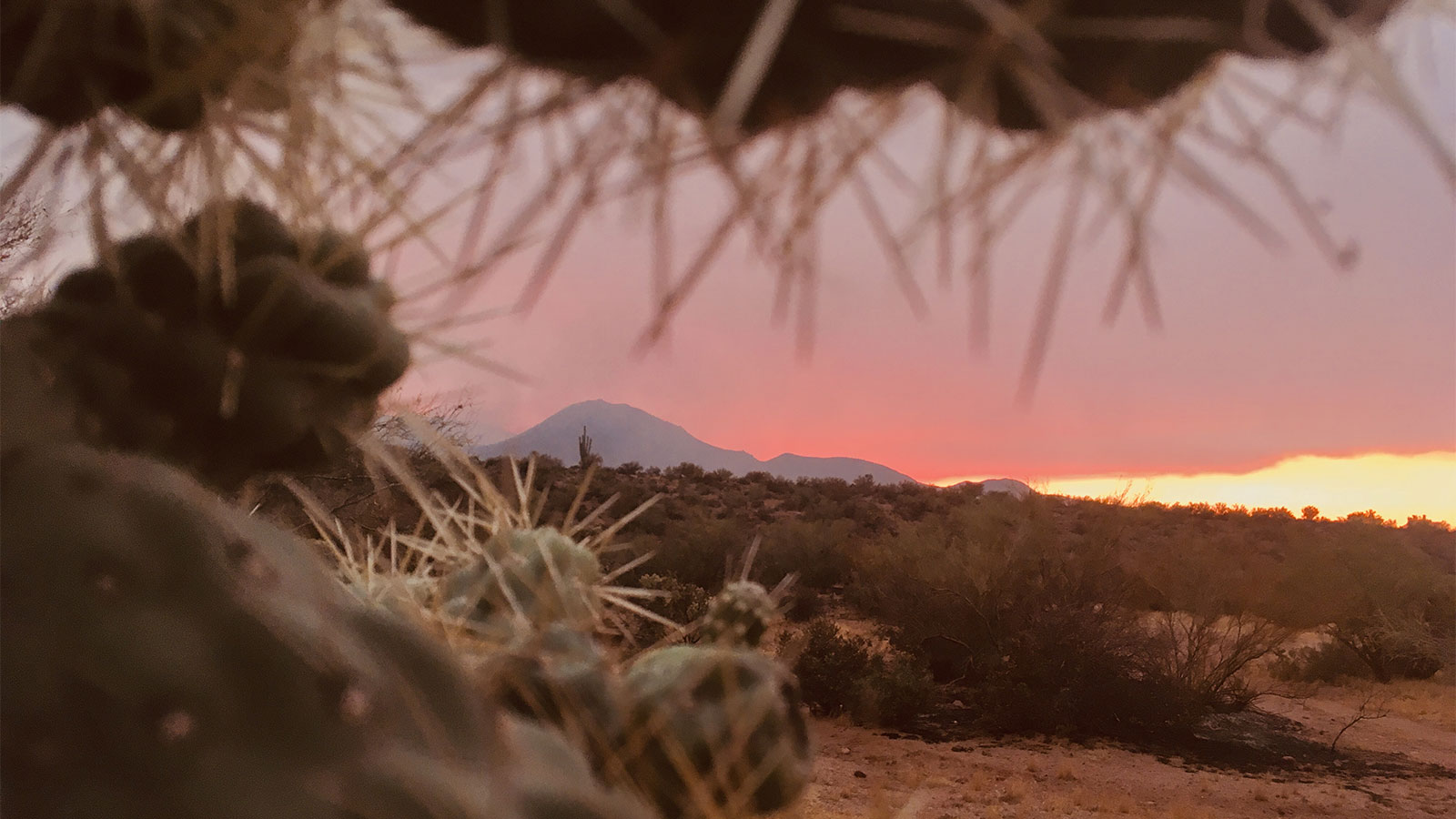
The sun sets amid a 2019 wildfire in Tonto National Forest. Alexandru Oarcea
A wildland firefighter’s base pay is only around $12 to $16 an hour. The real money is in overtime pay, which for Oarcea is $18 an hour, and hazard pay, which is an extra 25 percent on top of a firefighter’s base pay. When there’s no fire to fight, crews don’t get overtime or hazard pay. O’Reilly doesn’t think anyone who is physically exhibiting symptoms will be able to sneak past him. But he’s concerned that asymptomatic firefighters who might not know they’re sick could contaminate the rest of the crew.
“Without really good testing there’s nothing we can do really to make sure everyone who comes to work every day is really healthy,” he said. In late April, the CDC changed its testing guidelines to add firefighters to the high-priority category for testing. But they have to have symptoms to qualify for a test — and testing supplies are still limited in many parts of the country.
Firefighters who are hospitalized with COVID-19 will have to prove they contracted it on the job to receive workers compensation — wage replacement and medical benefits in exchange for agreeing not to sue an employer. But determining exactly when and how a person got the virus is challenging.
The Department of Labor has loosened its protocols so that federal employees who have a high likelihood of contracting the virus through the nature of their work — like first responders and front-line medical personnel — can get workers’ comp. But that recognition doesn’t extend to wildland firefighters, who “are currently not classified as high risk,” a Department of Labor spokesperson told Grist. “Someone in a position not designated ‘high risk’ can still provide evidence that establishes they contracted COVID-19 at work.”
Kraake, of the Forest Service’s Pacific Northwest region, said her team is “proactively working on systems for screening, testing, quarantining, and tracking our firefighters to maximize their safety as well as the safety of their families and communities.” She didn’t offer specifics on how soon such systems will be implemented.
It’s hard to get a clear picture of who is and isn’t getting tested on wildland firefighting crews across the country so far, but Oarcea said the Forest Service won’t pay for testing of his unit in Arizona. “If we test positive then we can open a case with the Department of Labor to try to prove its work-related,” he said via text message in early May.
The 2019 fire season was unexpectedly quiet compared to previous seasons, which means right now there’s a buildup of new growth — fuel for wildfires — in forests across the country. Blazes could run rampant in 2020 not just due to those conditions or the coronavirus itself but because the COVID-19 pandemic has prompted agencies to slash services and staffing numbers due to safety concerns.
Already, the Forest Service has cut down on prescribed burns (controlled fires started by firefighters meant to reduce the amount of brush and debris that builds up in forests) and managed burns (fires that start on their own that are then allowed by firefighters to continue if the conditions are right). The agency made the decision to reduce the amount of smoke that firefighters and the public are exposed to so as to lessen the compounding risks of coronavirus and air pollution. But the move could put firefighters at a slight disadvantage in regions where prescribed and managed burns help reduce the severity or size of unplanned forest fires.
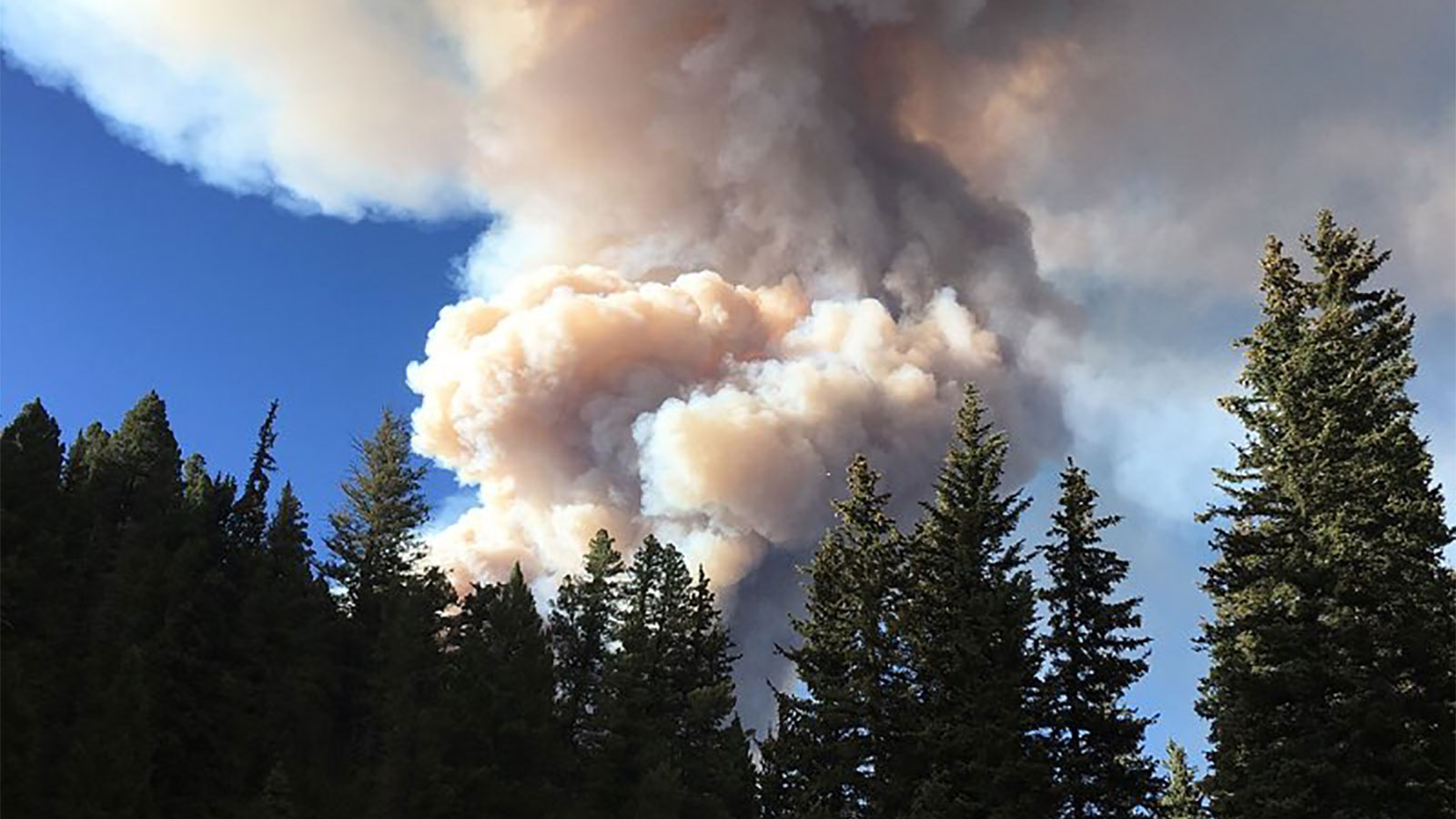
A plume of smoke towers above the trees during a 2018 wildfire in New Mexico. Alexandru Oarcea
“I understand why there’s not any prescribed burning going on right now, “ Selby said. “My personal opinion is that there should always be more prescribed burning going on than there already is.”
But the lack of personnel is the more pressing issue. This year’s seasonal workforce could be smaller than usual in some parts of the country. In a normal season, crews from Oregon and other states where fire season hits a bit later in the summer would be driving south and east right about now to states like Arizona in case crews like Oarcea’s need backup. But they’re staying put because of the coronavirus. And many of the wildland firefighting crews that are hiring pushed back start dates by two, four, even six weeks.
Arizona will be short-staffed this year for another reason, too. The state’s department of corrections normally sends 12 crews of prisoners to fight fires each season. Those prisoners won’t be deployed this year because the state doesn’t have a way to quarantine the prisoners for 21 days after the season is over before it brings them back into lockup. “Whether we need them or not, there’s going to be a shortage compared to a normal year,” Oarcea said.
That personnel shortfall could hinder crews’ firefighting capabilities come summer.
The National Multi-Agency Coordinating Group’s Southwest regional plan notes that the state of Arizona, where Oarcea works, only has a finite number of firefighting resources. “[N]o one base or location has enough backup resources to cover personnel absences,” the plan reads, “even in the event of a small to moderate percentage of individuals becoming unavailable due to exposure to COVID‐19.” That means the state will be forced to lean on resources from other states in the event of a big fire. The National Multi-Agency Coordinating Group’s regional plan for the South suggests consulting with Australian fire superintendents — who had to work with an exhausted workforce during that country’s historic 2019-2020 wildfire season.
Meanwhile, the fire forecast for May, June, and July from the National Interagency Fire Center’s Predictive Services program forecasts above-normal fire potential and activity across much of California, Oregon, and portions of the Great Basin and the northern Rockies. Wildfires have already sprung up and been contained in Texas, Florida, and other states.
Last month, an ominous study conducted by Columbia University scientists warned that the American West appears to be entering a “megadrought” due, in part, to climate change. Dry conditions could help recreate a fire year like the one the U.S. experienced in 2018, when California had its worst fire season ever. Or we could get a repeat of last year, when states braced for a catastrophic fire season that didn’t quite come to pass. It’s still too early to tell.
All of the new unknowns this year have Brendan O’Reilly, the Oregon hotshot leader, feeling nervous about the start of fire season. He told Grist he’s never felt as much responsibility to his crew as he does this year.
“I’m used to feeling a fair amount of responsibility for people’s safety as it pertains to the wildland fire portion of our job,” O’Reilly said. “But I’ve certainly never felt a lot of responsibility to people’s families and housemates and their greater lives just by bringing them to work.”

